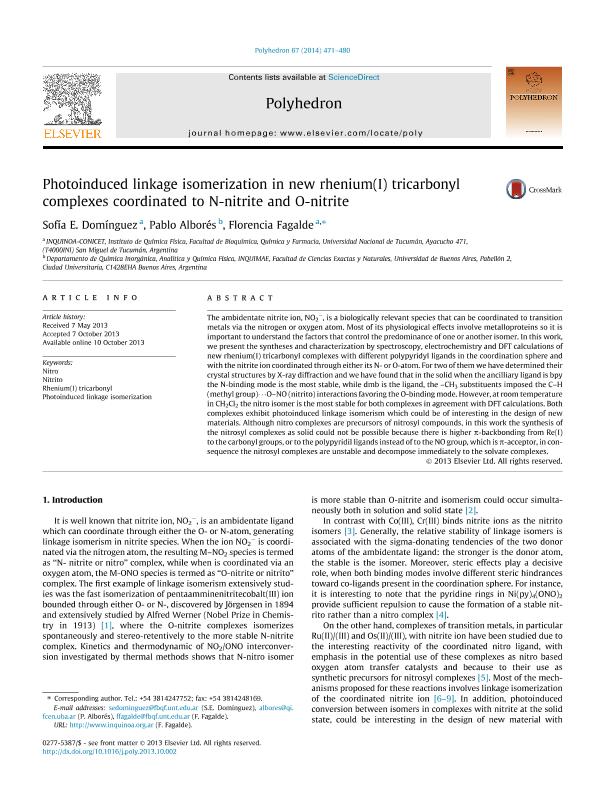Mostrar el registro sencillo del ítem
dc.contributor.author
Domínguez, Sofía Eugenia

dc.contributor.author
Alborés, Pablo

dc.contributor.author
Fagalde, Florencia

dc.date.available
2017-12-11T21:14:41Z
dc.date.issued
2013-10
dc.identifier.citation
Domínguez, Sofía Eugenia; Alborés, Pablo; Fagalde, Florencia; Photoinduced linkage isomerization in new rhenium(I) tricarbonyl complexes coordinated to N-nitrite and O-nitrite; Elsevier; Polyhedron; 67; 10-2013; 471-480
dc.identifier.issn
0277-5387
dc.identifier.uri
http://hdl.handle.net/11336/30209
dc.description.abstract
The ambidentate nitrite ion, NO2−, is a biologically relevant species that can be coordinated to transition metals via the nitrogen or oxygen atom. Most of its physiological effects involve metalloproteins so it is important to understand the factors that control the predominance of one or another isomer. In this work, we present the syntheses and characterization by spectroscopy, electrochemistry and DFT calculations of new rhenium(I) tricarbonyl complexes with different polypyridyl ligands in the coordination sphere and with the nitrite ion coordinated through either its N- or O-atom. For two of them we have determined their crystal structures by X-ray diffraction and we have found that in the solid when the ancilliary ligand is bpy the N-binding mode is the most stable, while dmb is the ligand, the –CH3 substituents imposed the C–H (methyl group)⋯O–NO (nitrito) interactions favoring the O-binding mode. However, at room temperature in CH2Cl2 the nitro isomer is the most stable for both complexes in agreement with DFT calculations. Both complexes exhibit photoinduced linkage isomerism which could be of interesting in the design of new materials. Although nitro complexes are precursors of nitrosyl compounds, in this work the synthesis of the nitrosyl complexes as solid could not be possible because there is higher π-backbonding from Re(I) to the carbonyl groups, or to the polypyridil ligands instead of to the NO group, which is π-acceptor, in consequence the nitrosyl complexes are unstable and decompose immediately to the solvate complexes.
dc.format
application/pdf
dc.language.iso
eng
dc.publisher
Elsevier

dc.rights
info:eu-repo/semantics/openAccess
dc.rights.uri
https://creativecommons.org/licenses/by-nc-nd/2.5/ar/
dc.subject
Nitro
dc.subject
Nitrito
dc.subject
Rhenium (I) Tricarbonyl
dc.subject
Photoinduced Linkage Isomerization
dc.subject.classification
Otras Ciencias Químicas

dc.subject.classification
Ciencias Químicas

dc.subject.classification
CIENCIAS NATURALES Y EXACTAS

dc.title
Photoinduced linkage isomerization in new rhenium(I) tricarbonyl complexes coordinated to N-nitrite and O-nitrite
dc.type
info:eu-repo/semantics/article
dc.type
info:ar-repo/semantics/artículo
dc.type
info:eu-repo/semantics/publishedVersion
dc.date.updated
2017-12-11T19:26:33Z
dc.journal.volume
67
dc.journal.pagination
471-480
dc.journal.pais
Países Bajos

dc.journal.ciudad
Amsterdam
dc.description.fil
Fil: Domínguez, Sofía Eugenia. Consejo Nacional de Investigaciones Científicas y Técnicas. Centro Científico Tecnológico Conicet - Tucumán. Instituto de Química del Noroeste. Universidad Nacional de Tucumán. Facultad de Bioquímica, Química y Farmacia. Instituto de Química del Noroeste; Argentina
dc.description.fil
Fil: Alborés, Pablo. Consejo Nacional de Investigaciones Científicas y Técnicas. Oficina de Coordinación Administrativa Ciudad Universitaria. Instituto de Química, Física de los Materiales, Medioambiente y Energía. Universidad de Buenos Aires. Facultad de Ciencias Exactas y Naturales. Instituto de Química, Física de los Materiales, Medioambiente y Energía; Argentina
dc.description.fil
Fil: Fagalde, Florencia. Consejo Nacional de Investigaciones Científicas y Técnicas. Centro Científico Tecnológico Conicet - Tucumán. Instituto de Química del Noroeste. Universidad Nacional de Tucumán. Facultad de Bioquímica, Química y Farmacia. Instituto de Química del Noroeste; Argentina
dc.journal.title
Polyhedron

dc.relation.alternativeid
info:eu-repo/semantics/altIdentifier/doi/http://dx.doi.org/10.1016/j.poly.2013.10.002
dc.relation.alternativeid
info:eu-repo/semantics/altIdentifier/url/http://www.sciencedirect.com/science/article/pii/S0277538713006943
Archivos asociados
